| PIP | Title | Description |
|---|---|---|
| 3B1 | Distribute Transportation Projection | Enables shipment requesters to notify transport service providers of currently booked shipments, and allows transport service providers to perform day-to-day management of shipment space to plan for the usual volume or exceptions or remote shipments that require special handling. |
| 3B2 | Notify of Advance Shipment | Enables shippers to send advance shipment and shipper's manifest notifications. |
| 3B3 | Distribute Shipment Status | Lets transport service providers report shipment status, via notifications, while shipments are being transported to end-consignees or gateways to be tendered to other transport service providers. |
| 3B4 | Query Shipment Status | Enables in-transit information users to query shipment status, and allows transport service providers to respond with shipment status notifications. |
| 3B5 | Request Shipment Change | Allows shipment controllers to change or redirect in-transit shipments to end-consignees or gateways. |
| 3B6 | Notify of Shipments Tendered | Allows transport service providers to report delivery exceptions while shipments are in transit to end-consignees. |
| 3B11 | Notify Of Shipping Order | Enables the Inventory Owner to issue a shipping authorization to the Logistics Service Provider to ship inventory against another document, e.g., sales order, scrap order, replacement order, demo or sample order. Shipping Order becomes a traceable document for audit purposes. Inventory detail is specified according to the TPA terms of engagement between the Logistics Provider and it's client. |
| 3B12 | Request Shipping Order | This PIP is designed to enable the communication of shipping orders from a manufacturer or distributor with outsourced logistics operations to its third-party logistics provider. |
| 3B13 | Notify of Shipping Order Confirmation | This PIP is designed to enable a third-party logistics provider to confirm that a requested shipment has been sent on behalf of a manufacturer or distributor that uses outsourced logistics operations. |
| 3B14 | Request Shipping Order Cancellation | This PIP is designed to enable the cancellation of previously placed shipping orders. A shipping order is an instruction from a manufacturer or distributor with outsourced logistics operations to its third-party logistics provider. |
| 3B18 | Notify of Shipment Documentation | This PIP is designed to enable the communication of shipping documentation information from a manufacturer or distributor with outsourced logistics operations to its third-party logistics provider. |
| 3B19 | Notify of Shipping Order Request | This PIP enables a shipper to place a shipping order to its shipping provider. |
| 3B20 | Notify of Shipping Order Confirmation | This PIP enables a shipping provider to reply to a shipping order request of the shipper. |
| 3B21 | Notify of Shipping Order Cancellation Request | This PIP enables a shipper to cancellation a shipping order. |
| 3B22 | Notify of Shipping Order Cancellation Confirmation | For example, a manufacturer of semiconductor components may store completed products at a warehouse operated by another company and need to request a third-party to ship the components to its customer whenever a sales order is received. Documentation to accompany the shipment is required. |
Download Transportation and Distribution specifications.
- 3B1_DistributeTransportationProjection_R01_00_00A
- 3B2_NotifyofAdvanceShipment_V01_00_00
- 3B2_NotifyofAdvanceShipment_V01_01_00
- 3B2_NotifyofAdvanceShipment_V01_02_00
- 3B2_NotifyofAdvanceShipment_V01_03_00
- PIP3B2_V11.00.00_NotifyOfAdvanceShipment
- PIP3B2_V11.01.00_NotifyOfAdvanceShipment
- PIP3B2_V11.02.00_NotifyOfAdvanceShipment
- PIP3B2_V11.03.00_NotifyOfAdvanceShipment
- PIP3B2_V11.04.00_NotifyOfAdvanceShipment
- 3B3_DistributeShipmentStatus_R01_00_00A
- PIP3B3_V11.00.00_DistributeShipmentStatus
- PIP3B3_V11.11.00_DistributeShipmentStatus
- PIP3B3_V11.12.00_DistributeShipmentStatus
- 3B4_QueryShipmentStatus_R01_00_00A
- 3B5_RequestShipmentChange_R01_00_00A
- 3B6_NotifyOfShippersManifest_R01_00_00A
- 3B11_NotifyOfShippingOrder_R01_00_00A
- 3B11_NotifyOfShippingOrder_V01_00_00
- 3B12_RequestShippingOrder_V01_00_00
- 3B12_RequestShippingOrder_V01_01_00
- 3B12_RequestShippingOrder_V01_02_00
- 3B12_RequestShippingOrder_V01_03_00
- PIP3B12_V11.00.00_RequestShippingOrder
- PIP3B12_V11.01.00_RequestShippingOrder
- PIP3B12_V11.02.00_RequestShippingOrder
- PIP3B12_V11.03.00_RequestShippingOrder
- PIP3B12_V11.04.00_RequestShippingOrder
- 3B13_NotifyOfShippingOrderConfirmation_V01_00_00
- 3B13_NotifyOfShippingOrderConfirmation_V01_01_00
- 3B13_NotifyOfShippingOrderConfirmation_V01_03_00
- 3B13_NotifyOfShippingOrderConfirmation_V01_04_00
- PIP3B13_V11.00.00_NotifyOfShippingOrderConfirmation
- 3B14_RequestShippingOrderCancellation_V01_00_00
- 3B14_RequestShippingOrderCancellation_V01_01_00
- 3B14_RequestShippingOrderCancellation_V01_02_00
- PIP3B14_V11.00.01_RequestShippingOrderCancellation
- PIP3B14_V11.01.00_RequestShippingOrderCancellation
- PIP3B14_V11.02.00_RequestShippingOrderCancellation
- 3B18_NotifyOfShippingDocumentation_V01_00_00
- 3B18_NotifyOfShippingDocumentation_V01_01_00
- 3B18_NotifyOfShippingDocumentation_V01_02_00
- PIP3B18_V11.00.00_NotifyOfShippingDocumentation
- PIP3B18_V11.01.00_NotifyOfShippingDocumentation
- PIP3B18_V11.10.00_NotifyOfShippingDocumentation
- PIP3B18_V11.11.00_NotifyOfShippingDocumentation
- PIP3B18_V11.12.01_NotifyOfShippingDocumentation
- 3B19_NotifyOfShippingOrderRequest_V01_00_00
- 3B19_NotifyOfShippingOrderRequest_V01_01_00
- PIP3B19_V11.00.00_ NotifyOfShippingOrderRequest
- 3B20_NotifyOfShippingOrderConfirmation_V01_00_00
- 3B20_NotifyOfShippingOrderConfirmation_V01_01_00
- PIP3B20_V11.00.00_NotifyOfShippingOrderConfirmation
- PIP3B21_V11.00.00_NotifyOfShippingOrderCancellationRequest
- 3B21_NotifyOfShippingOrderCancellationRequest_V01_00_00
- 3B22_NotifyOfShippingOrderCancellationConfirmation_V01_00_00
- PIP3B22_V11.00.00_NotifyOfShippingOrderCancellationConfirmation
- Cluster 3, Order Management, Supports full order management business area from price and delivery quoting through purchase order initiation, status reporting, and management.Order invoicing, payment and discrepancy notification also managed using this Cluster of processes.
- PIPs for Segment 3B, Transportation and Distribution, Enables communication of shipping- and delivery-related information with the ability to make changes and handle exceptions and claims.
| 3B1 | Distribute Transportation Projection |
|---|---|
| Enables shipment requesters to notify transport service providers of currently booked shipments, and allows transport service providers to perform day-to-day management of shipment space to plan for the usual volume or exceptions or remote shipments that require special handling. |
Business Process

The "Distribute Transportation Projection" Partner Interface Process™ (PIP®) enables a party needing transportation services (shipment requester) to send a transportation projection to a transport service provider. A transportation projection is provided for shipments that are booked, but not yet sent. The projection enables a transport service provider to manage normal day-to-day events such as special handling requirements of remote shipments. For example, a transportation projection is required when a shipment will be exported.
A service requester could be a consignee, shipper, broker, agent, freight forwarder, consignor, transport buyer, carrier, or anyone related to the business function of the shipment. A shipment requester may or may not hold goods.
A transport service provider is a party that adds value to the process of moving goods from one place to another. For example: Consolidators, warehousing entities, freight forwarders, documentation personnel, carriers or custom clearing personnel.
This PIP® is not used to request bids. Rates and terms are worked out in advance per the Trading Partner Agreement.
Should this transaction not complete successfully, the requesting partner executes PIP0A1, "Notification of Failure".
| 3B2 | Notify of Advance Shipment |
|---|---|
| Enables shippers to send advance shipment and shipper's manifest notifications. |
Business Process
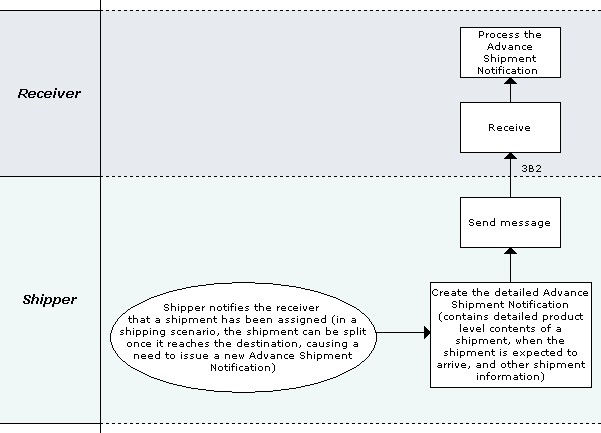
The "Notify of Advance Shipment" Partner Interface Process (PIP) allows a Shipper to notify a Receiver that a shipment has been assigned.The purpose of the Advance Shipment Notification is to communicate at the detailed product level the contents of a shipment, when the shipment is expected to arrive, and other shipment information.
This Notification is often a part of the shipment process.In a shipping scenario, the shipment can be split once it reaches the destination, causing a need to issue a new Advance Shipment Notification.
This Notification is intended to satisfy shipment data needs of shippers and receivers.
Should this transaction not complete successfully, the requesting partner executes PIP0A1, "Notification of Failure".
| 3B3 | Distribute Shipment Status |
|---|---|
| Lets transport service providers report shipment status, via notifications, while shipments are being transported to end-consignees or gateways to be tendered to other transport service providers. |
Business Process

The "Distribute Shipment Status" Partner Interface Process (PIP) enables a transport service provider to distribute shipment status information to another party, such as a consignee, a third-party logistics firm, a shipper, or another transport service provider.
A transport service provider is a party that adds value to the process of moving goods from one place to another. For example: Consolidators, warehousing entities, freight forwarders, documentation personnel, carrier, or custom clearing personnel.
Shipment status can be distributed:
- Any time after a shipment has been tendered (accepted and placed in transit) by a transport service provider.
- As specified in a trading partner agreement.
- As a follow-up to the execution of PIP3B4, "Query Shipment Status."
- After a shipment reaches a consignee to notify other parties of shipment delivery expectations.
- To notify a partner of delivery exceptions (e.g., shipment lost, delivery address not found, store not open).
Shipment status information monitors the progress of a shipment. It is a "snapshot" of the status of goods in transit to an end consignee or a gateway (a point at which freight moving from one territory to another is interchanged between transportation lines).
Should this transaction not complete successfully, the requesting partner executes PIP0A1, "Notification of Failure".
| 3B4 | Query Shipment Status |
|---|---|
| Enables in-transit information users to query shipment status, and allows transport service providers to respond with shipment status notifications. |
Business Process

The "Query Shipment Status" Partner Interface Process (PIP) enables (1) a party, such as a consignee, third-party logistics firm, or shipper, to query for the status of one or more shipments, and (2) a transport service provider to answer the query.
A transport service provider is a party that adds value to the process of moving goods from one place to another, for example: consolidators, warehousing entities, freight forwarders, documentation personnel, carriers or custom clearing personnel.
This PIP can be used:
- While a shipment is in transit (left the pick-up site).
- After the shipment has been delivered to a consignee or gateway.
The response to the query may report a delivery exception (e.g., lost shipment, delivery address not found, store not open).
The requesting party initiates the process by sending a shipment status query to the transport service provider. To facilitate communications, the query document includes both query constraint lines and incomplete results lines. After processing the query, the transport service provider completes the results lines and returns the information to the requesting party.
Should this transaction not complete successfully, the requesting partner executes PIP0A1, "Notification of Failure".
| 3B5 | Request Shipment Change |
|---|---|
| Allows shipment controllers to change or redirect in-transit shipments to end-consignees or gateways. |
Business Process

The "Request Shipment Change" Partner Interface Process™ (PIP®) enables a shipment controller to communicate a shipment requirement change to a transport service provider while the shipment is in transit.
A shipment controller is a party authorized to change or redirect a shipment, such as a consignee, transport service provider, or third-party logistics firm. Only payer of transit and authorized agent of payer of transit can request a shipment change (by contract).
A transport service provider is a party that adds value to the process of moving goods from one place to another, such a consolidator, warehousing entity, carrier or freight forwarder.
Examples of shipment changes:
- Re-consignment.
- Destination change to handle a manufacturing return.
PIP4B2, "Notify of Shipment Receipt," may be used after this PIP® executes to report the status of a received shipment to another interested party, such as another consignee, a transport service provider, a third-party logistics firm, or a shipper.
Should this transaction not complete successfully, the requesting partner executes PIP0A1, "Notification of Failure".
| 3B6 | Notify of Shipments Tendered |
|---|---|
| Allows transport service providers to report delivery exceptions while shipments are in transit to end-consignees. |
Business Process
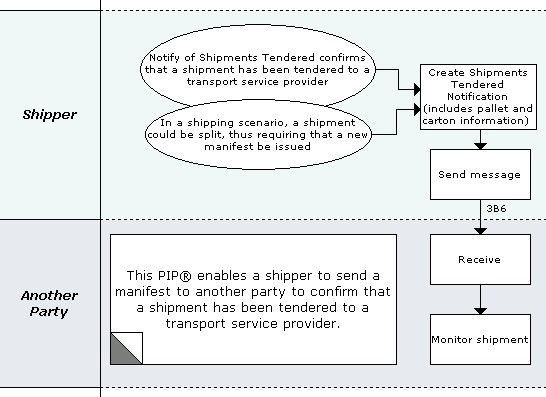
The "Notify of Shipments Tendered" Partner Interface Process™ (PIP®) enables a shipper to send a manifest to another party. A manifest confirms that a shipment has been tendered to a transport service provider and includes pallet and carton information.
The party to whom the manifest is sent could be a consignee, third-party logistics firm, regulatory agency, freight consolidator, warehousing entity, packaging provider, freight forwarder, documentation manager, customs clearing unit, carrier or other stakeholder in the tendering activity. The information contained in the shipper's manifest may be used to create other manifests.
This PIP® often supports the tender shipment process.
In a shipping scenario, a shipment could be split, thus requiring that a new manifest be issued.
Should this transaction not complete successfully, the requesting partner executes PIP0A1, "Notification of Failure".
| 3B11 | Notify Of Shipping Order |
|---|---|
| Enables the Inventory Owner to issue a shipping authorization to the Logistics Service Provider to ship inventory against another document, e.g., sales order, scrap order, replacement order, demo or sample order. Shipping Order becomes a traceable document for audit purposes. Inventory detail is specified according to the TPA terms of engagement between the Logistics Provider and it's client. |
Business Process
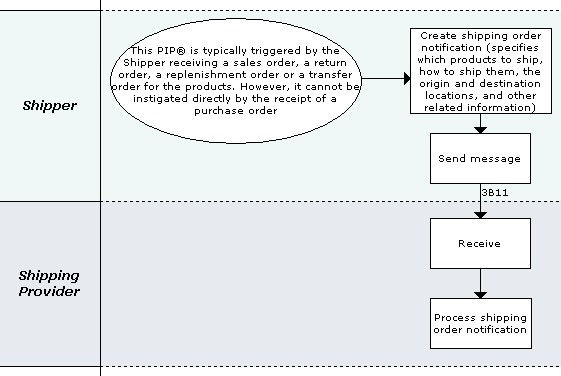
All businesses that sell products existing as physical goods, such as raw materials, components and finished goods, must deliver them from their manufacturing or storage location to the customer's location. This physical movement of products may involve several parties. The first party to the shipment is usually the seller, which initiates the shipping of the products. The second party is the usually the buyer, as the consignee to which the products are shipped. Additionally, there may be third-party logistics (3PL) and even fourth-party logistics (4PL) providers, offering services to the shipper such as outsourced light manufacturing, product warehousing, routing and tracking, in addition to physically transporting the products.
The "Notify of Shipping Order" Partner Interface Process (PIP) supports a process between two of these parties, in which a Shipper authorizes a Shipping Provider to ship products from one location to another. The Shipper is the organization responsible for the supply of products to its customers, i.e. the first party described above. The Shipping Provider is a third-party that performs the shipping logistics on behalf of the Shipper.
The Shipper uses this PIP to send the Shipping Provider a shipping order that specifies which products to ship, how to ship them, the origin and destination locations, and other related information. This is typically triggered by the Shipper receiving a sales order, a return order, a replenishment order or a transfer order for the products. However, it cannot be instigated directly by the receipt of a purchase order.
Only one shipping order is issued per transaction. If more than one authorization to ship products is required, or if the products are to be shipped via one or more intermediate locations, multiple shipping orders must be sent.While a shipping order is typically used to initiate the pick-and-pack and shipment of products by the Shipping Provider for delivery to the customer, there are several other ways in which it may be used. For example, it may be a response to a replenishment order from a third-party warehouse, whereby the Shipping Provider is asked to transport an additional supply of products from a factory to the warehouse. Another example might be where defective goods have been returned to a distribution center, and the Shipper issues a shipping order to the Shipping Provider to move them to another location. Note that in this situation, the "Notify of Shipping Order" PIP is not intended to manage the process of negotiating the return from the customer, but can be used to move products once they have been returned to a distribution center.
Should this transaction not complete successfully, the requesting partner executes PIP0A1, "Notification of Failure".
| 3B12 | Request Shipping Order |
|---|---|
| This PIP is designed to enable the communication of shipping orders from a manufacturer or distributor with outsourced logistics operations to its third-party logistics provider. |
Business Process

All businesses that sell products existing as physical goods, such as raw materials, components and finished goods, must deliver them from their manufacturing or storage location to the customer's location. This physical movement of products may involve several parties. The first party to the shipment is usually the seller, which initiates the shipping of the products. The second party is the usually the buyer, as the consignee to which the products are shipped. Additionally, there may be third-party logistics (3PL) and even fourth-party logistics (4PL) providers, offering services to the shipper such as outsourced light manufacturing, product warehousing, routing and tracking, in addition to physically transporting the products.
The "Request Shipping Order" Partner Interface Process (PIP) supports a process between two of these parties, in which a Shipper authorizes a Shipping Provider to ship products from one location to another. The Shipper is the organization responsible for the supply of products to its customers, i.e. the first party described above. The Shipping Provider is a third-party that performs the shipping logistics on behalf of the Shipper.
The Shipper uses this PIP to send the Shipping Provider a shipping order and request a confirmation that it is valid. The shipping order specifies which products to ship, how to ship them, the origin and destination locations, and other related information. This is typically triggered by the Shipper receiving a sales order, a return order, a replenishment order or a transfer order for the products. However, it cannot be instigated directly by the receipt of a purchase order.
The Shipper transmits a Shipping Order Request business document to the Shipping Provider. The Shipping Provider responds with a Shipping Order Confirmation business document, which either confirms that the shipping order is valid or rejects it, giving an indication of why it is invalid.
This PIP authorizes the Shipping Provider only to make the shipment as described in the shipping order. The Shipping Provider is not authorized to make a partial shipment or deviate from the shipping order in any other way. If the Shipping Provider cannot complete the shipping order as requested, the shipping order must be rejected.Only one shipping order is issued per transaction. If more than one authorization to ship products is required, or if the products are to be shipped via one or more intermediate locations, multiple shipping orders must be sent.
While a shipping order is typically used to initiate the pick-and-pack and shipment of products by the Shipping Provider for delivery to the customer, there are several other ways in which it may be used. For example, it may be a response to a replenishment order from a third-party warehouse, whereby the Shipping Provider is asked to transport an additional supply of products from a factory to the warehouse. Another example might be where defective goods have been returned to a distribution center, and the Shipper issues a shipping order to the Shipping Provider to move them to another location. Note that in this situation, the "Request Shipping Order" PIP is not intended to manage the process of negotiating the return from the customer, but can be used to move products once they have been returned to a distribution center.
Should this transaction not complete successfully, the requesting partner executes PIP0A1, "Notification of Failure".
| 3B13 | Notify of Shipping Order Confirmation |
|---|---|
| This PIP is designed to enable a third-party logistics provider to confirm that a requested shipment has been sent on behalf of a manufacturer or distributor that uses outsourced logistics operations. |
Business Process
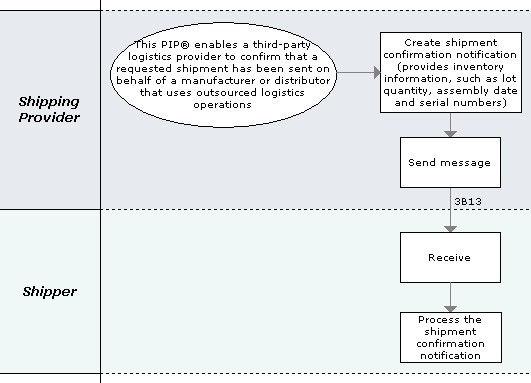
All businesses that sell products existing as physical goods, such as raw materials, components and finished goods, must deliver them from their manufacturing or storage location to the customer's location. This physical movement of products may involve several parties. The first party to the shipment is usually the seller, which initiates the shipping of the products. The second party is usually the buyer, as the consignee to which the products are shipped. Additionally, there may be third-party logistics (3PL) and even fourth-party logistics (4PL) providers, offering services to the shipper such as outsourced light manufacturing, product warehousing, routing and tracking, in addition to physically transporting the products.
The "Notify of Shipment Confirmation" Partner Interface Process (PIP) supports a process between two of these parties, in which a Shipping Provider notifies a Shipper that a previously authorized shipment has been dispatched. The Shipper is the organization responsible for the supply of products to its customers, i.e. the first party described above. The Shipping Provider is a third-party that performs the shipping logistics on behalf of the Shipping Provider.
The Shipper authorizes a Shipping Provider to ship products from one location to another by sending a shipping order using either PIP 3B11 "Notify of Shipping Order" or PIP 3B12 "Request Shipping Order". Subsequently, the Shipping Provider uses PIP 3B13 to confirm that the shipment has been sent.
Depending on the Trading Partner Agreement between the Shipper and the Shipping Provider, the Shipping Provider may be authorized to make a partial shipment if insufficient stock is on hand to complete the order. Similarly, the Shipping Provider may be authorized to make multiple partial shipments until the order has been completed, in which case multiple PIP 3B13 messages will be sent. Note that PIP 3B13 is not intended to be used to synchronize inventory information; a separate process should be used to limit the occurrence of partial shipments.
The Shipper may use the information received in PIP 3B13 to trigger the invoicing process.
Also on receipt of PIP 3B13, the Shipper may send PIP 3B2 "Notify of Advance Shipment" to the customer. PIP 3B13 provides inventory information, such as lot quantity, assembly date and serial numbers, that is required for inclusion in PIP 3B2 "Notify of Advance Shipment", allowing the customer to match the received products and enabling payment to the Shipper.
Should this transaction not complete successfully, the requesting partner executes PIP0A1, "Notification of Failure".
| 3B14 | Request Shipping Order Cancellation |
|---|---|
| This PIP is designed to enable the cancellation of previously placed shipping orders. A shipping order is an instruction from a manufacturer or distributor with outsourced logistics operations to its third-party logistics provider. |
Business Process
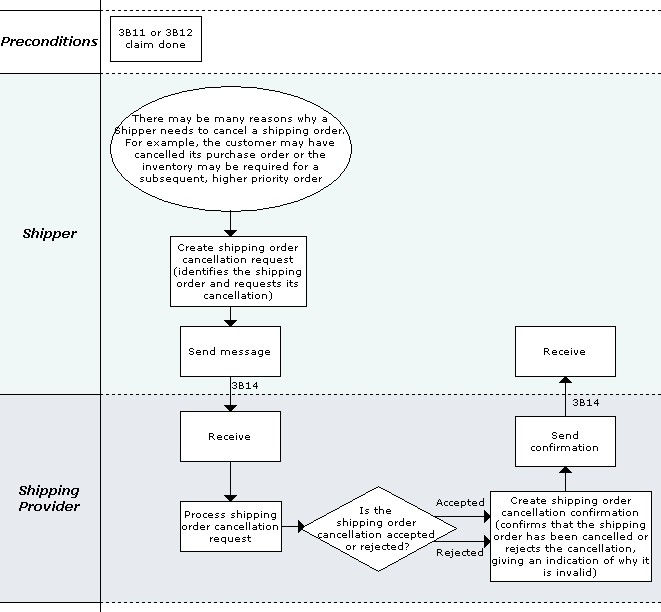
All businesses that sell products existing as physical goods, such as raw materials, components and finished goods, must deliver them from their manufacturing or storage location to the customer's location. This physical movement of products may involve several parties. The first party to the shipment is usually the seller, which initiates the shipping of the products. The second party is the usually the buyer, as the consignee to which the products are shipped. Additionally, there may be third-party logistics (3PL) and even fourth-party logistics (4PL) providers, offering services to the shipper such as outsourced light manufacturing, product warehousing, routing and tracking, in addition to physically transporting the products.
The "Request Shipping Order Cancellation" Partner Interface Process (PIP) supports a process between two of these parties, in which a Shipper cancels a shipping order that has been sent previously to a Shipping Provider. The Shipper is the organization responsible for the supply of products to its customers, i.e. the first party described above. The Shipping Provider is a third-party that performs the shipping logistics on behalf of the Shipper.
The Shipper authorizes a Shipping Provider to ship products from one location to another by sending a shipping order using either PIP 3B11 "Notify of Shipping Order" or PIP 3B12 "Request Shipping Order".
To cancel the shipping order the Shipper transmits a Shipping Order Cancellation Request business document to the Shipping Provider identifying the shipping order and requesting its cancellation. The Shipping Provider responds with a Shipping Order Cancellation Confirmation business document, which either confirms that the shipping order has been cancelled or rejects the cancellation, giving an indication of why it is invalid.
There may be many reasons why a Shipper needs to cancel a shipping order. For example, the customer may have cancelled its purchase order or the inventory may be required for a subsequent, higher priority order.
The Shipping Provider may not always be able to satisfy the cancellation request. For example, the shipment may have already been dispatched.
Should this transaction not complete successfully, the requesting partner executes PIP0A1, "Notification of Failure".
Should this transaction not complete successfully, the requesting partner executes PIP0A1, "Notification of Failure".
| 3B18 | Notify of Shipment Documentation |
|---|---|
| This PIP is designed to enable the communication of shipping documentation information from a manufacturer or distributor with outsourced logistics operations to its third-party logistics provider. |
Business Process
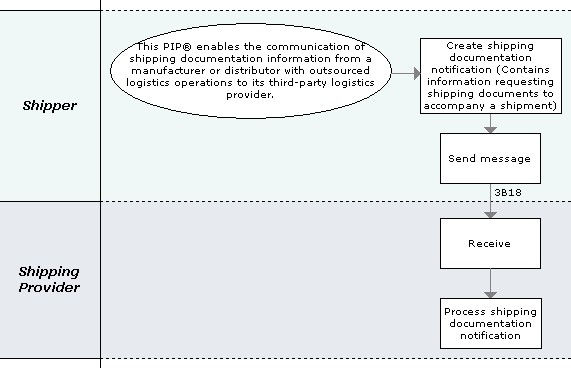
All businesses that sell products existing as physical goods, such as raw materials, components and finished goods, must deliver them from their manufacturing or storage location to the customer's location. This physical movement of products may involve several parties. The first party to the shipment is usually the seller, which initiates the shipping of the products. The second party is usually the buyer, as the consignee to which the products are shipped. Additionally, there may be third-party logistics (3PL) and even fourth-party logistics (4PL) providers, offering services to the shipper such as outsourced manufacturing, product warehousing, routing and tracking, in addition to physically transporting the products.
When products are shipped, they will often need to be accompanied by various shipping documents. These documents may include:
- Bill of Lading, a document issued by a carrier to a Shipper, signed by the captain agent or owner of the carrier, furnishing written evidence regarding receipt of goods, the conditions on which transport is made (contract of carriage) and the engagement to deliver the goods at the prescribed point of destination to the lawful holder of the bill of lading. Receipt for merchandise and a contract to deliver it as freight.
- Certificate of Origin, a document attesting to the country of origin of goods. Such certificates (or the format for them) are usually obtained through an official or quasi-official organization in the country of origin, such as a consular office or local chamber of commerce. A Certificate of Origin may be required even though the Commercial Invoice contains similar information. A Certificate of Origin is used by customs authorities to prove country of origin of goods. Country of origin can determine different import statuses, eligibility for quota programs, distinguish between different rates of duty or prove eligibility for preferential import programs.
- Commercial Invoice, a document identifying the seller and buyer of the goods or services, identifying numbers such as invoice number, date, shipping date, mode of transport, delivery and payment terms, and a complete listing and description of the goods being sold, including prices, discounts and quantities. A Commercial Invoice is used by governments to determine the true transaction value of the goods for assessment of customs duties and also to prepare consular documents.
- Export Declaration, a form required for all US Export shipments (with some exceptions) prepared by the Shipper indicating the value, weight, destination and other basic information about the shipment, including ECCN number, Schedule B number and license type information. The document is used to report and compile export statistics to the Department of Census as well as to control exports of certain types of materials and technology.
- Packing List, a document prepared by the Shipper listing the kinds and quantities of merchandise in a particular shipment. A copy is usually sent to the consignee and affixed to the packages to assist in checking the shipment contents when received. Packing lists contain similar information to the Commercial Invoice with the exclusion of prices and payment terms.
- Pro Forma Invoice, an invoice provided by the Shipper for customs purposes in lieu of a commercial invoice when a commercial invoice is not available at the time of merchandise entry or customs entry.
- Shippers Letter of Instruction, a form used by a Shipper to authorize a carrier, freight forwarder or third party agentto issue a Bill of Lading or air waybill on the Shipper's behalf. The form contains all details of shipment and authorizes the carrier to sign the Bill of Lading in the name of the Shipper.
The "Notify of Shipping Documentation" Partner Interface Process™ (PIP) supports a process in which a Shipper communicates information that a Shipping Provider must incorporate in the documentation to accompany a shipment. The Shipper is the organization responsible for the supply of products to its customers, i.e. the first party described above. The Shipping Provider is a third-party that performs the shipping logistics on behalf of the Shipper.
Usually the Shipper will already have sent the Shipping Provider a shipping order to specify which products to ship, how to ship them, the origin and destination locations, and other related information. PIP 3B11 Notify of Shipping Order or PIP 3B12 Request Shipping Order will have been used for this purpose.
Sometimes the shipping documentation information is sent to a different Shipping Provider than the Shipping Provider to which the shipping order is sent. An example of this is where another party provides shipping services for the same shipment, such as where the Shipping Provider is a third-party export administrator.
PIP 3B18 Notify of Shipping Documentation is also designed to support the Shipper's labeling requirements, sufficient for the Shipping Provider to create a shipping label for the shipment. This is an adhesive label containing information such as consignee name, address, shipment identification numbers and carton count information.
The Shipper may ask for additional, proprietary, documents to be generated by a Shipping Provider from the information passed in PIP 3B18 Notify of Shipping Documentation, which will be specified in the Trading Partner Agreement.
While a shipment is authorized by only a single instance of either PIP 3B11 Notify of Shipping Order or PIP 3B12 Request Shipping Order, each shipment may have multiple occurrences of PIP 3B18 Notify of Shipping Documentation. For the shipping documents required to support a given shipment, the following scenarios are possible:
- The Shipper may transmit a single 3B18 for all the shipping documents to a single Shipping Provider.
- The Shipper may transmit a separate 3B18 for each shipping document to a single Shipping Provider.
- The Shipper may transmit a separate 3B18 to several different Shipping Providers, each of which has been contracted by the Shipper to manage a specific set of shipping documents.
PIP 3B18 Notify of Shipping Documentation is usually transmitted after the applicable PIP 3B11 Notify of Shipping Order or PIP 3B12 Request Shipping Order that authorizes the shipment. However, it is possible to send 3B18 before 3B11 or 3B12, so the Shipping Provider can prepare the shipping documentation in advance.
For simple domestic shipments, PIPs 3B11 and 3B12 may contain sufficient information for the Shipping Provider to generate all necessary shipping documentation without the use of PIP 3B18. However, the documentation for international shipments will require the use of PIP 3B18.
Should this transaction not complete successfully, the requesting partner executes PIP0A1, "Notification of Failure".
| 3B19 | Notify of Shipping Order Request |
|---|---|
| This PIP enables a shipper to place a shipping order to its shipping provider. |
Business Process

All businesses that sell products existing as physical goods, such as raw materials, components and finished goods, must deliver them from their manufacturing or storage location to the customer's location. This physical movement of products may involve several parties. The first party to the shipment is usually the seller, which initiates the shipping of the products. The second party is the usually the buyer, as the consignee to which the products are shipped. Additionally, there may be third-party logistics (3PL) and even fourth-party logistics (4PL) providers, offering services to the shipper such as outsourced light manufacturing, product warehousing, routing and tracking, in addition to physically transporting the products.
The "Notify of Shipping Order Request" Partner Interface Process (PIP) supports a process between two of these parties, in which a Shipper authorizes a Shipping Provider to ship products from one location to another. The Shipper is the organization responsible for the supply of products to its customers, i.e. the first party described above. The Shipping Provider is a third-party that performs the shipping logistics on behalf of the Shipper.
The Shipper uses this PIP to send the Shipping Provider a shipping order and request a confirmation that it is valid. The shipping order specifies which products to ship, how to ship them, the origin and destination locations, and other related information. This is typically triggered by the Shipper receiving a sales order, a return order, a replenishment order or a transfer order for the products. However, it cannot be instigated directly by the receipt of a purchase order.
The Shipper transmits a Shipping Order Request business document to the Shipping Provider. The Shipping Provider responds with a Shipping Order Confirmation business document, which either confirms that the shipping order is valid or rejects it, giving an indication of why it is invalid.
This PIP authorizes the Shipping Provider only to make the shipment as described in the shipping order. The Shipping Provider is not authorized to make a partial shipment or deviate from the shipping order in any other way. If the Shipping Provider cannot complete the shipping order as requested, the shipping order must be rejected.Only one shipping order is issued per transaction. If more than one authorization to ship products is required, or if the products are to be shipped via one or more intermediate locations, multiple shipping orders must be sent.
While a shipping order is typically used to initiate the pick-and-pack and shipment of products by the Shipping Provider for delivery to the customer, there are several other ways in which it may be used. For example, it may be a response to a replenishment order from a third-party warehouse, whereby the Shipping Provider is asked to transport an additional supply of products from a factory to the warehouse. Another example might be where defective goods have been returned to a distribution center, and the Shipper issues a shipping order to the Shipping Provider to move them to another location. Note that in this situation, the "Request Shipping Order" PIP is not intended to manage the process of negotiating the return from the customer, but can be used to move products once they have been returned to a distribution center.
Should this transaction not complete successfully, the requesting partner executes PIP0A1, "Notification of Failure".
| 3B20 | Notify of Shipping Order Confirmation |
|---|---|
| This PIP enables a shipping provider to reply to a shipping order request of the shipper. |
Business Process
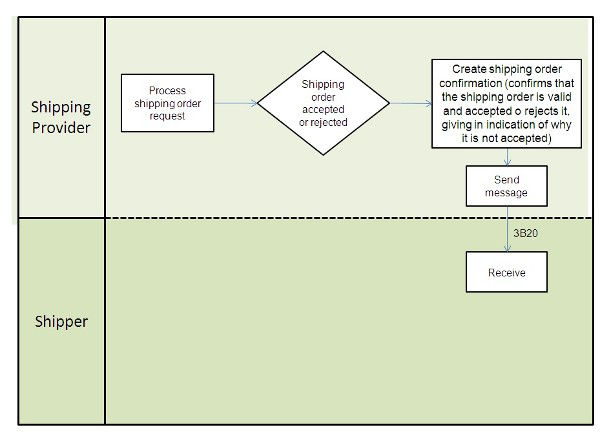
All businesses that sell products existing as physical goods, such as raw materials, components and finished goods, must deliver them from their manufacturing or storage location to the customer's location. This physical movement of products may involve several parties. The first party to the shipment is usually the seller, which initiates the shipping of the products. The second party is the usually the buyer, as the consignee to which the products are shipped. Additionally, there may be third-party logistics (3PL) and even fourth-party logistics (4PL) providers, offering services to the shipper such as outsourced light manufacturing, product warehousing, routing and tracking, in addition to physically transporting the products.
The "Notify of Shipping Order Confirmation" Partner Interface Process (PIP) supports a process between two of these parties, in which a Shipper authorizes a Shipping Provider to ship products from one location to another. The Shipper is the organization responsible for the supply of products to its customers, i.e. the first party described above. The Shipping Provider is a third-party that performs the shipping logistics on behalf of the Shipper.
The Shipper uses this PIP to send the Shipping Provider a shipping order and request a confirmation that it is valid. The shipping order specifies which products to ship, how to ship them, the origin and destination locations, and other related information. This is typically triggered by the Shipper receiving a sales order, a return order, a replenishment order or a transfer order for the products. However, it cannot be instigated directly by the receipt of a purchase order.
The Shipper transmits a Shipping Order Request business document to the Shipping Provider. The Shipping Provider responds with a Shipping Order Confirmation business document, which either confirms that the shipping order is valid or rejects it, giving an indication of why it is invalid.
This PIP authorizes the Shipping Provider only to make the shipment as described in the shipping order. The Shipping Provider is not authorized to make a partial shipment or deviate from the shipping order in any other way. If the Shipping Provider cannot complete the shipping order as requested, the shipping order must be rejected.Only one shipping order is issued per transaction. If more than one authorization to ship products is required, or if the products are to be shipped via one or more intermediate locations, multiple shipping orders must be sent.
While a shipping order is typically used to initiate the pick-and-pack and shipment of products by the Shipping Provider for delivery to the customer, there are several other ways in which it may be used. For example, it may be a response to a replenishment order from a third-party warehouse, whereby the Shipping Provider is asked to transport an additional supply of products from a factory to the warehouse. Another example might be where defective goods have been returned to a distribution center, and the Shipper issues a shipping order to the Shipping Provider to move them to another location. Note that in this situation, the "Request Shipping Order" PIP is not intended to manage the process of negotiating the return from the customer, but can be used to move products once they have been returned to a distribution center.
Should this transaction not complete successfully, the requesting partner executes PIP0A1, "Notification of Failure".
| 3B21 | Notify of Shipping Order Cancellation Request |
|---|---|
| This PIP enables a shipper to cancellation a shipping order. |
Business Process
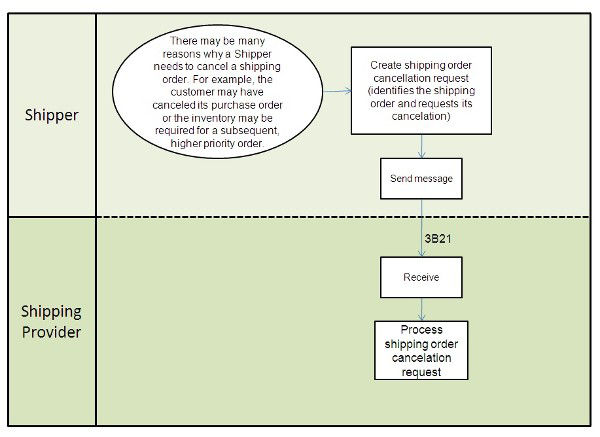
All businesses that sell products existing as physical goods, such as raw materials, components and finished goods, must deliver them from their manufacturing or storage location to the customer's location. This physical movement of products may involve several parties. The first party to the shipment is usually the seller, which initiates the shipping of the products. The second party is the usually the buyer, as the consignee to which the products are shipped. Additionally, there may be third-party logistics (3PL) and even fourth-party logistics (4PL) providers, offering services to the shipper such as outsourced light manufacturing, product warehousing, routing and tracking, in addition to physically transporting the products.
The "Notify of Shipping Order Cancellation Request" Partner Interface Process (PIP) supports a process between two of these parties, in which a Shipper cancels a shipping order that has been sent previously to a Shipping Provider. The Shipper is the organization responsible for the supply of products to its customers, i.e. the first party described above. The Shipping Provider is a third-party that performs the shipping logistics on behalf of the Shipper.
The Shipper authorizes a Shipping Provider to ship products from one location to another by sending a shipping order using either PIP 3B11 "Notify of Shipping Order" or PIP 3B12 "Request Shipping Order".
To cancel the shipping order the Shipper transmits a Shipping Order Cancellation Request business document to the Shipping Provider identifying the shipping order and requesting its cancellation. The Shipping Provider responds with a Shipping Order Cancellation Confirmation business document, which either confirms that the shipping order has been cancelled or rejects the cancellation, giving an indication of why it is invalid.
There may be many reasons why a Shipper needs to cancel a shipping order. For example, the customer may have cancelled its purchase order or the inventory may be required for a subsequent, higher priority order.
The Shipping Provider may not always be able to satisfy the cancellation request. For example, the shipment may have already been dispatched.
Should this transaction not complete successfully, the requesting partner executes PIP0A1, "Notification of Failure".
| 3B22 | Notify of Shipping Order Cancellation Confirmation |
|---|---|
| For example, a manufacturer of semiconductor components may store completed products at a warehouse operated by another company and need to request a third-party to ship the components to its customer whenever a sales order is received. Documentation to accompany the shipment is required. |
Business Process
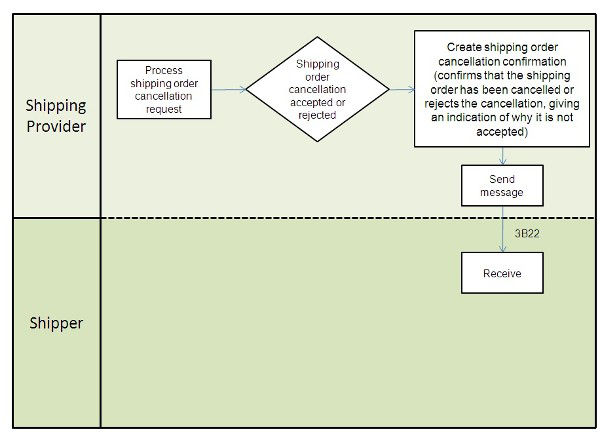
All businesses that sell products existing as physical goods, such as raw materials, components and finished goods, must deliver them from their manufacturing or storage location to the customer's location. This physical movement of products may involve several parties. The first party to the shipment is usually the seller, which initiates the shipping of the products. The second party is the usually the buyer, as the consignee to which the products are shipped. Additionally, there may be third-party logistics (3PL) and even fourth-party logistics (4PL) providers, offering services to the shipper such as outsourced light manufacturing, product warehousing, routing and tracking, in addition to physically transporting the products.
The "Notify of Shipping Order Cancellation Request" Partner Interface Process (PIP) supports a process between two of these parties, in which a Shipper cancels a shipping order that has been sent previously to a Shipping Provider. The Shipper is the organization responsible for the supply of products to its customers, i.e. the first party described above. The Shipping Provider is a third-party that performs the shipping logistics on behalf of the Shipper.
The Shipper authorizes a Shipping Provider to ship products from one location to another by sending a shipping order using either PIP 3B11 "Notify of Shipping Order" or PIP 3B12 "Request Shipping Order".
To cancel the shipping order the Shipper transmits a Shipping Order Cancellation Request business document to the Shipping Provider identifying the shipping order and requesting its cancellation. The Shipping Provider responds with a Shipping Order Cancellation Confirmation business document, which either confirms that the shipping order has been cancelled or rejects the cancellation, giving an indication of why it is invalid.
There may be many reasons why a Shipper needs to cancel a shipping order. For example, the customer may have cancelled its purchase order or the inventory may be required for a subsequent, higher priority order.
The Shipping Provider may not always be able to satisfy the cancellation request. For example, the shipment may have already been dispatched.
Should this transaction not complete successfully, the requesting partner executes PIP0A1, "Notification of Failure".
